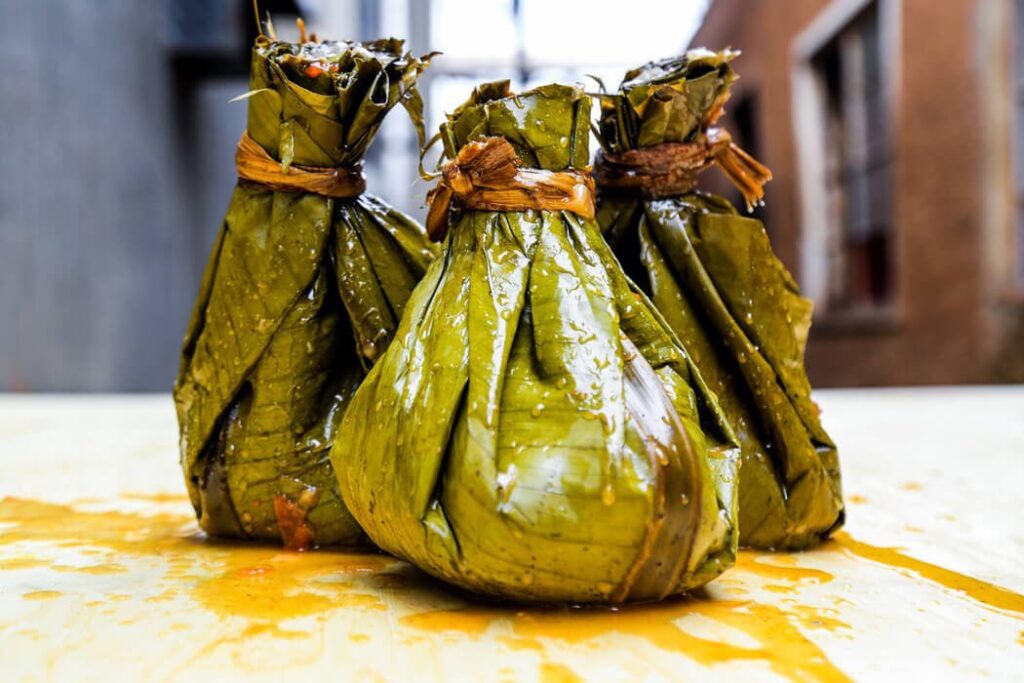
How Ugandans Celebrate Christmas | Experiya Tour Company
October 29, 2025
Is Matoke Really the National Dish of Uganda? | Experiya Tour Company
October 29, 2025What Local Foods Should I Try in Uganda?
Uganda, often described as the Pearl of Africa, is not only blessed with lush green landscapes, lakes, and wildlife but also with a culinary tradition as rich and diverse as its people. Food in Uganda tells the story of its regions, its hospitality, and its cultural pride. Every dish has a story, every flavor a meaning — whether shared around a family table, served at a local market stall, or enjoyed during a festival.
Ugandan cuisine is known for being wholesome, flavorful, and deeply satisfying. The dishes are prepared with fresh, organic ingredients, mostly sourced from fertile soils and local farms. For travelers eager to experience authentic East African dining, Uganda offers a wide range of delicacies that reflect its cultural diversity and agricultural abundance. From banana-based staples to aromatic stews, smoky grilled meats, and sweet tropical fruits, Uganda’s culinary landscape is a journey worth savoring.
Let’s explore the most iconic local foods you should try when visiting Uganda — each one a delicious window into the country’s soul.
Matoke – The Heart of Ugandan Cuisine
If there’s one dish that defines Uganda, it’s matoke. Often referred to as the national dish, matoke consists of green bananas that are peeled, wrapped in banana leaves, and steamed until soft. The bananas are then mashed and served with a rich sauce made from groundnuts, beef, beans, or chicken.
Matoke is more than just food — it’s a symbol of Ugandan identity. It’s served at weddings, funerals, and daily family meals alike. In Buganda, where the dish originated, matoke is treated with great respect and is a staple in nearly every household.
The flavor is mild yet comforting, and the texture soft and filling. Travelers can enjoy matoke in almost any local restaurant, roadside eatery, or family home across Uganda.
Posho – The Simple Staple
Posho, also known as ugali or kawunga, is a thick porridge made from maize flour cooked in boiling water until it forms a firm, dough-like consistency. It’s a staple food across East Africa and a common accompaniment to stews, beans, or vegetables.
Posho is simple but satisfying — the kind of food that fills the stomach and energizes you for the day ahead. It’s especially popular in schools and homes because it’s affordable and versatile. In many local restaurants, you’ll see Ugandans eating posho with beans stew, beef, or sukuma wiki (collard greens).
The experience of eating posho with your hands, as most locals do, adds an authentic touch to your Ugandan dining adventure.
Luwombo – A Royal Dish with Deep Roots
Among the Baganda people of central Uganda, luwombo is a dish fit for kings — literally. It’s said to have originated in the royal kitchens of the Buganda Kingdom during the 19th century and has remained a beloved delicacy ever since.
Luwombo is a stew of chicken, beef, groundnuts, or mushrooms, carefully wrapped in banana leaves and steamed to perfection. The banana leaves infuse the dish with a smoky, earthy aroma that makes it distinct from any other stew you’ll ever taste.
It’s traditionally served with matoke, rice, or sweet potatoes. Preparing luwombo is a labor of love — a process that requires patience, skill, and respect for tradition. When visiting Kampala or the surrounding regions, don’t miss the chance to savor this flavorful dish, often prepared for holidays, weddings, and other special occasions.

Groundnut Sauce – The Ugandan Peanut Delight
Peanut sauce, locally called ebinyebwa, is one of Uganda’s most popular accompaniments. Made from roasted and ground peanuts, this creamy sauce is rich, nutty, and slightly sweet. It pairs beautifully with matoke, sweet potatoes, cassava, or rice.
Groundnut sauce can be made with vegetables or meat and often features local spices that give it a comforting depth of flavor. In many Ugandan homes, it’s a staple dish that embodies both simplicity and richness. Travelers will find it served at nearly every buffet or home-cooked meal, often as a vegetarian option that doesn’t compromise on flavor.
Rolex – Uganda’s Street Food Legend
When you think of Uganda’s street food, one word comes to mind — Rolex. No, not the luxury watch — but something even better for your taste buds. The Ugandan Rolex is a delicious and portable meal consisting of a chapati (flatbread) rolled up with eggs, onions, tomatoes, and sometimes cabbage or avocado.
The name “Rolex” comes from “rolled eggs,” and it has become one of Uganda’s most iconic foods. You’ll find Rolex stands on nearly every street corner, especially in Kampala and university towns. It’s quick, tasty, and affordable — the perfect snack for travelers on the go.
Each vendor adds their own twist, so no two Rolexes taste exactly alike. Pair it with a cold soda or fresh juice, and you’ll have one of the most authentic Ugandan street food experiences.
Eshabwe – The Ghee Sauce of the West
In the western regions of Ankole and Tooro, eshabwe is a delicacy made from ghee (clarified butter), salt, and occasionally milk or water. It’s a rich, creamy sauce traditionally served cold alongside millet bread, matoke, or sweet potatoes.
Eshabwe is often reserved for special guests or ceremonies such as weddings and harvest celebrations. The Banyankole, known for their cattle-keeping heritage, take great pride in this dish, which symbolizes purity and abundance.
Its flavor is distinct — buttery, slightly salty, and deeply satisfying. For travelers looking to experience the authentic cuisine of Uganda’s cattle country, eshabwe is a must-try.
Malakwang – A Northern Delight
In northern Uganda, particularly among the Acholi and Lango people, malakwang is a popular traditional dish. It’s made from a tangy green vegetable (also called malakwang) that’s boiled and mixed with groundnut paste to create a rich, sour-sweet sauce.
Malakwang is typically served with millet bread, posho, or sweet potatoes. Its unique flavor profile — both tart and nutty — makes it unlike any other dish in Uganda. It’s a great example of how Ugandan cuisine embraces regional ingredients and bold flavors.
Pilau – Fragrant Rice with a Twist
A dish influenced by Indian and Arab traders, pilau is a spiced rice dish that has become a festive favorite in Uganda, especially during celebrations such as Christmas, weddings, and Eid.
Pilau is cooked with aromatic spices like cinnamon, cardamom, cloves, and cumin, combined with meat, vegetables, or beans. The result is a flavorful, golden-brown rice dish that’s both hearty and fragrant.
In Kampala, Jinja, and Fort Portal, you’ll find pilau served in restaurants and homes alike, often accompanied by salad or a cold soda. It’s a symbol of hospitality and togetherness, bringing people together during shared meals.
Chapati – The Soft Flatbread Favorite
Borrowed from Indian cuisine but made uniquely Ugandan, chapati is a round, soft flatbread fried in oil and often enjoyed with beans, eggs, or stew. It’s a common breakfast item but can be eaten at any time of day.
Ugandan chapati tends to be thicker and softer than its Indian counterpart, and locals love it for its versatility. Whether served alongside meat or rolled into a Rolex, chapati is a beloved comfort food that no traveler should miss.
Sweet Potatoes, Cassava, and Yams – The Traditional Staples
Uganda’s fertile soils produce an abundance of root crops that form the foundation of the local diet. Sweet potatoes, cassava, and yams are staples in many regions, served boiled, roasted, or mashed.
Sweet potatoes are often eaten with tea for breakfast, while cassava is enjoyed as a side dish during lunch or dinner. Roasted cassava, sold by street vendors, makes for a popular snack — crispy on the outside and soft on the inside.
These humble foods are not just sustenance; they are part of the daily rhythm of Ugandan life, connecting people through shared meals and traditions.
Local Drinks – A Taste of Uganda’s Thirst Quenchers
To accompany your meal, Uganda offers a variety of refreshing local drinks. Bushera, a traditional fermented sorghum or millet drink, is common in western Uganda. It’s slightly tangy and believed to aid digestion.
For something sweeter, try fresh fruit juice made from pineapples, mangoes, passion fruits, or sugarcane — all grown locally. Adventurous travelers can also sample local brews like malwa (a millet-based drink) or tonto (a banana wine), which are shared communally during celebrations.
Fruits – Nature’s Dessert
Uganda’s tropical climate makes it a paradise for fruit lovers. Fresh pineapples, mangoes, papayas, jackfruit, and watermelons are sold on nearly every street and roadside stand.
Ugandan pineapples, in particular, are considered among the sweetest in the world. Trying them freshly sliced from a market stall is an experience that will redefine your idea of tropical flavor.
Why Ugandan Food Is Special
Ugandan cuisine is not about fancy ingredients or complicated recipes — it’s about freshness, community, and tradition. Meals are cooked slowly, often shared from the same dish, and enjoyed with laughter and storytelling. Every bite connects you to the land and its people.
When you sit down to a Ugandan meal, you’re not just eating — you’re participating in a centuries-old tradition of hospitality, respect, and togetherness.
Why You Should Travel With Experiya Tour Company
To truly taste Uganda, you need to experience it locally — in the markets, villages, and family kitchens where the country’s culinary heart beats strongest. That’s where Experiya Tour Company comes in.
Experiya specializes in authentic, immersive travel experiences that go beyond sightseeing. Their culinary-focused tours take travelers deep into Uganda’s food culture — from cooking classes with local chefs and market visits to traditional village meals and street food tastings.
With knowledgeable guides and strong community partnerships, Experiya ensures you savor every flavor while supporting local farmers, cooks, and artisans. Whether you’re sampling matoke in a homestead near Bwindi, rolling a Rolex in Kampala, or sharing a luwombo meal in Buganda, Experiya crafts experiences that bring the taste of Uganda to life.
Book your culinary journey with Experiya Tour Company and let your taste buds explore the Pearl of Africa — one flavorful dish at a time.




